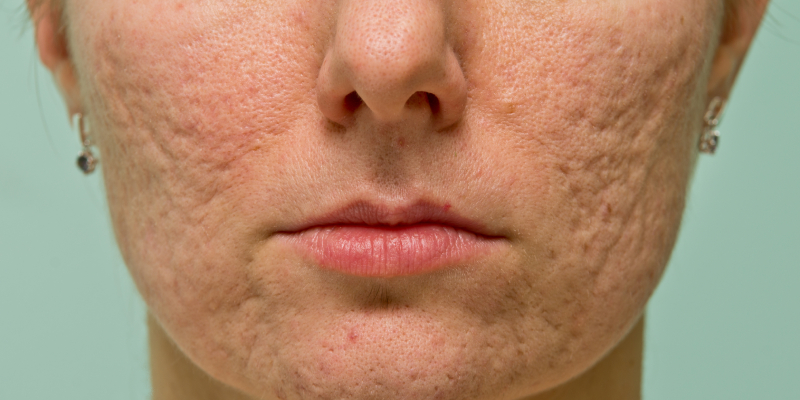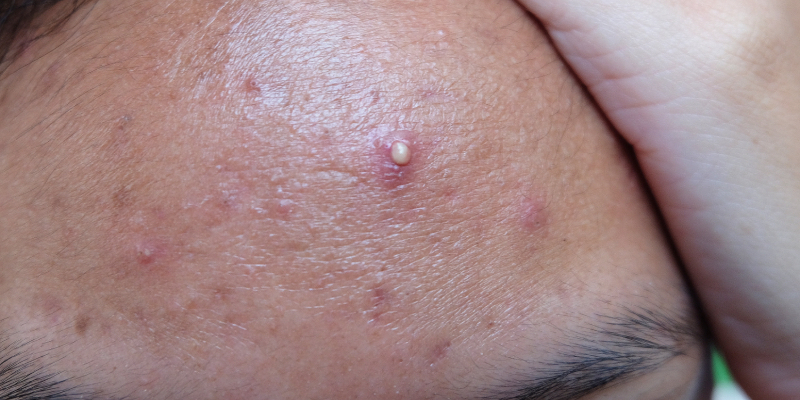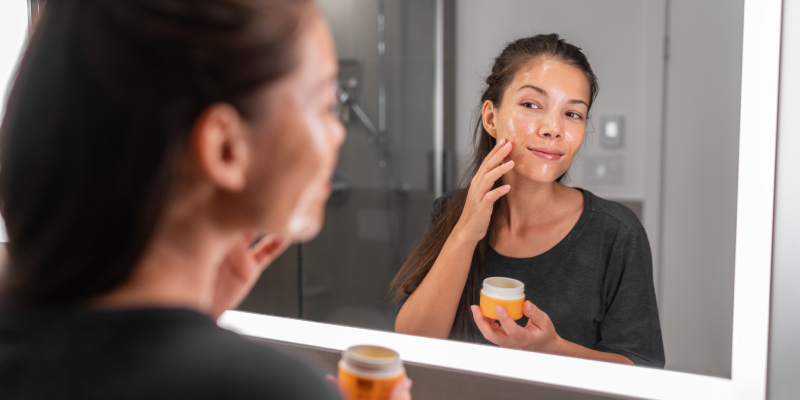Acne affects 80% of individuals between the ages of 11 and 30, and 1 in 5 of those affected will develop scars. It’s commonly thought that acne scars, like other scars, are permanent and cannot be treated. However, those suffering from the lasting impacts of acne will be delighted to hear that it is possible to reduce the appearance of the scars and, in many cases, remove them for good. In this article, we’ll be walking you through the best acne scar treatments, all of which are available at our skin clinic in Milton Keynes. Keep reading if you want to understand how to get rid of acne scars, and get in touch with the LasaDerm team for a treatment plan tailored to your skin.
How To Get Rid Of Acne Scars For Good
Before you can begin tending to your acne scars, you’ll need to treat your acne once and for all because new breakouts can lead to new scars. Additionally, some of the treatments outlined below can’t be done alongside typical acne medications and may worsen your condition. So, if you’re struggling with clogged pores and problematic skin, check out our article on the best acne treatments to cut out the root cause of scarring.

Acne Scarring Causes
Acne scarring, unsurprisingly, is caused by acne. An acne lesion develops when bacteria, oils and dead skin cause inflammation of the skin’s pores. Pores are tiny openings in the skin that allow oil and sweat to rise to the surface, but bacteria can build within them quickly when blocked. Acne is the most common skin condition in the world. It is very common among teenagers due to their changing hormones and in adults due to stress, menstrual cycles, the environment, and various types of medication.
There are six types of acne, but typically, only four of them lead to scarring:
- Papules: Bumps underneath the surface of the skin that appear solid, tender, and raised. Often, the skin surrounding a papule is also inflamed.
- Pustules: Larger than papules, pustules are tender bumps with white/yellow pus at the centre. This pus is a combination of the immune cells and bacteria blocking the pore. The area surrounding a pustule will be red or pink on light skin and brown or black on darker skin.
- Nodules: These solid lesions extend deep into the skin, making them more sensitive to the touch than papules and pustules. Nodules develop when a clogged pore has become infected, but they often have no visible head, making this form of acne more severe than it might appear.
- Cysts: The most severe type of acne, cysts lie deep within the skin and are full of pus. They’re very large and painful, often needing surgical intervention to treat them.

Each of these lesions has the potential to damage the walls of your pores, allowing the bacteria within to spill into the surrounding tissue. Once damaged, your skin will form new collagen fibres, resulting in scarring. Usually, an individual with acne scarring will have more than one of the following types:
- Ice Pick: This type of scar resembles its namesake, as it’s wide at the top and narrows as it goes deeper into the skin. These scars are very common and difficult to heal. They’re typically found on the forehead and upper cheek, where the skin is thinner.
- Rolling: The indents have sloping edges, making the skin look uneven and wavy. They’re typically found on the lower cheeks and jaw.
- Boxcar: These scars have sharp edges that penetrate deep into the skin. They’re most common on the lower cheeks and jaw.
- Hypertrophic/Keloid: This is where the scar tissue rises from the skin and is caused by the collagen used to repair damaged tissue.

Best Treatment For Acne Scar Removal
There are many treatments available for the removal of acne scars, and the best option for you will depend on your specific circumstances. Depending on your scar type, skin type, and the severity of scarring, one or a combination of the following approaches may lead to improvements in your skin’s appearance.
Intense Pulsed Light (IPL)
IPL uses lightwaves that specifically target structures within your skin. Yellow, green, and red light are emitted into the skin in a series of short pulses, stimulating collagen production. Excess collagen production plumps the skin, improving the appearance of scarring. IPL also addresses acne triggers, reducing the likelihood of future breakouts.
Skin Peels
Chemical skin peels work by removing the top layer of the skin, allowing healthy skin to present itself. They’re one of the most effective ways to rejuvenate dry and damaged skin. Not only do they remove dead skin cells at the surface, but they also stimulate collagen production. We recommend skin peels from The Perfect Peel and Elementrē for the best results.
Microneedling
Also known as skin needling or dermarolling, microneedling can help treat a variety of skin concerns, including acne scars. The treatment involves pricking the skin with a number of fine needles, kickstarting the natural healing process. According to the American Academy of Dermatology, microneedling works best for depressed, not raised, scars.
Microdermabrasion
During microdermabrasion, your skin specialist will use a small handheld device to gently remove the outer layer of your skin (epidermis), revealing smooth and healthy skin underneath. Again, this treatment works best on depressed scars and may not be as effective following a nodular or cystic breakout.
Hydrafacial
Similarly to microdermabrasion, a hydrafacial removes the top layer of skin to reduce hyperpigmentation and stimulate collagen production. The treatment begins with gentle cleansing and exfoliation to eliminate dead skin cells before applying a mild chemical peel to promote a smoother texture. The impurities will be extracted from your pores before an intensely hydrating serum is applied to the skin.
Best Skincare For Acne Scars
While consulting a dermatologist is the most effective way to improve the appearance of your acne scarring, at-home remedies and skincare alternatives can help you achieve similar results. To give your skin the best chance at recovering, you need to keep an eye out for a few key ingredients:
Azelaic Acid
This lesser-known skincare ingredient is one of the best for fading acne scars. Its dual mechanism works to renew skin cells while killing the bacteria that cause acne. Azelaic acid is found in grains like rye, wheat, and barley and helps to reduce inflammation, even for those with sensitive skin. The ILUMA Intense Brightening Serum from Image skincare combines azelaic acid with vitamin C to rejuvenate the skin.
Retinol
Retinoids, like retinol, are vitamin A derivatives and play a key role in skin health. They offer a multitude of benefits, including reducing inflammation, unclogging pores, and regulating the growth of cells on the surface of the skin. Skincare products that include retinol will accelerate cell turnover, stimulating collagen production. By speeding up the exfoliation process, your skin will feel fresh and smooth. We recommend Image Skincare’s Total Retinol-A Creme to access the benefits retinol has to offer.

Vitamin C
Vitamin C is a must for combatting acne scarring due to its powerful skin-brightening and collagen-boosting abilities. It’s been found to inhibit melanin production, helping to even out the pigmentation from acne scars. Vitamin C, like many of the other ingredients in this list, boosts collagen production and plumps up the skin. It’s often listed as L-ascorbic acid (the name of its chemical structure) in product ingredient lists, so keep an eye out for that.
Salicylic Acid
Salicylic acid is common in many skincare products because it can get deep into pores and clean out any excess oil, dead skin cells, and bacteria. In addition to preventing new breakouts, it helps to smooth out the uneven texture of acne scarring. Salicylic acid also has anti-inflammatory properties, so it will help reduce acne-related swelling. These properties make it best suited to those with oily, acne-prone skin. For an effective treatment, try out Image Skincare’s Salicylic Clarifying Tonic.
Lactic Acid
A milder option for those with dry or sensitive skin, lactic acid lightly exfoliates the skin’s outer layers to diminish the appearance of acne scars. It also has humectant properties, meaning it will attract and retain moisture, fostering healthier skin. Look for lotions containing 5-10% lactic acid, and only use them once or twice weekly. Excessive exposure to lactic acid will further damage the skin.

Patience Is Paramount
Acne scars can be extremely frustrating, but it’s important not to give up too soon after starting a course of treatment. Often, individuals only begin to see results after multiple sessions with their dermatologist or a lengthy period following a consistent skincare routine. Prevention remains the best treatment method for acne scars, so if you experience a breakout, avoid picking, popping, or squeezing the spots.
For more information regarding acne scarring and its treatments or to better understand your skin, get in touch with the team at Lasaderm. At our cosmetic clinic in Milton Keynes, we’ll assess your condition and develop a bespoke treatment plan to suit your circumstances.
